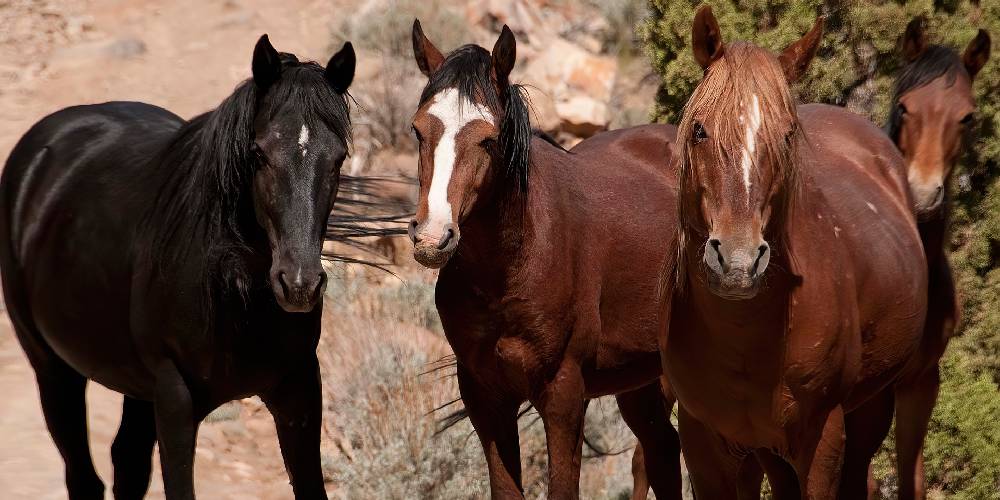I have seen many different documentaries on the wild horses of North America. These horses are known as mustangs and can be found all over the United States. Mustangs can be caught and tamed to be used by humans which is unique to wild horses as other wild breeds, such as the Przewalski’s Horse, can not be tamed. Mustangs can be used for nearly anything and can come in nearly every color. This breed is increasing in popularity for human use every day, so learning about these horses interested me.
What Is A Mustang?
A Mustang is a breed or type of wild horse found in North America, especially in the United States. These wild horses are descended from domesticated horses that were brought to North America by the Spanish in the 1400s and 1500s. Mustangs are generally small, stocky horses with hard feet and fairly good conformation. They live in herds with between 6 to 15 members and can come in virtually any color. Today, they mainly roam the United States in the states of Montana, Idaho, Nevada, Wyoming, Utah, Oregon, California, Arizona, North Dakota, and New Mexico.
How Big Can Mustangs Be?
Mustangs are usually pretty small to average sized horses and stand between 14.2 and 16 hands high. The reason for this big range in height is due to the many breeds that they are crossed with.
The average mustang weight between 800 and 1,100 pounds. Larger, heavier mustangs will weight just over 1,000 pounds while the smaller, lighter mustangs will weigh in just below 1,000 pounds.
What Colors & Patterns Can A Mustang’s Coat Be?
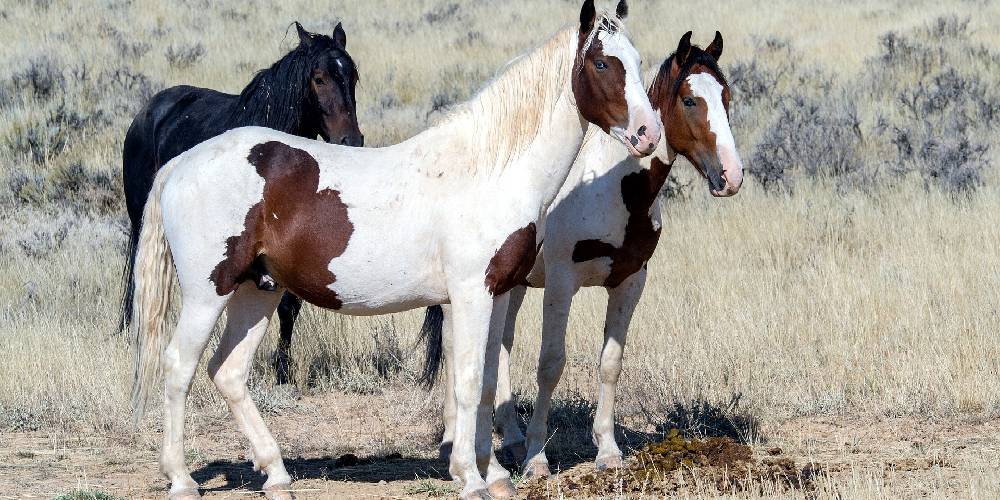
Mustangs are a mix of a ton of different breeds of horses including Appaloosas, Spanish Horses, Quarter Horses, Thoroughbreds, Paint Horses, and more. Sometimes, if a horse gets loose, it can find itself in a herd of mustangs and contribute to the genetic pool of that herd.
Thanks to the many random genes found in the Mustang breed, these horses can be any color. These colors include:
- Black
- Bay (can be blood bay, black bay, dark bay, and light bay)
- Chestnut (can be sorrel, liver chestnut, light chestnut, or flaxen chestnut)
- Gray (can be flea-bitten)
- White or Albino
- Buckskin
- Palomino
- Red Roan (strawberry roan is acceptable too)
- Blue Roan
- Bay Roan
- Cremello
- Perlino
- Grullo
- Dun
This breed can also be seen in virtually every color pattern imagineable, as well as have any markings on their face or legs. The coat and color patterns that these horses can be include:
- Overo
- Tovero
- Tobiano
- Sabino
- Blanket Spot Pattern
- Snowflake Spot Pattern
- Leopard Spot Pattern
- Snowcap Marking
Thanks to their diverse and unique genetics, these horses can be seen as almost any color or pattern imaginable.
The History Of The Mustang
Mustangs are horses with a unique past. These horses originally came to the Americas with the Spanish conquistadors. The horse was an animal that natives had never seen before and they believed that the conquistadors on their horses were come kind of Gods.
The Spanish took advantage of the Native people and began to take over their civilizations. With them, the Spanish brought horrible sicknesses that the native people had never been introduced to such as smallpox. The Spanish took their horses and brought them up north through modern-day Mexico. In what is now known as the United States, the Spanish began to build churches and places to live. Their horses bred and their numbers began to grow.
During their time in Mexico and through travels up through to the United States, the Spanish destroyed many native tribes, one being the Aztec. The Spanish horses went with them through their trip and on their way some of these horses got loose or were turned out. These horses who got away from the Spanish began to breed and grow in population, creating some of the first wild mustangs. As more and more of these horses got away from humans, the more the numbers of wild horses grew.
When more people brought different horses over, some of these too escaped and joined the herds of mustangs. Now, the mustang has been bred with so many different breeds that it is hard to tell where all the different traits they carry come from.
How To Identify The Mustang
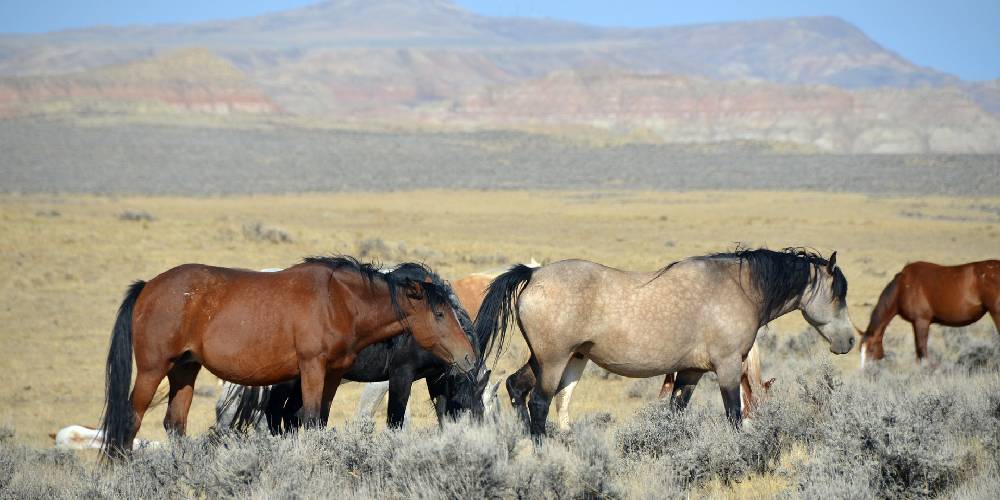
The mustang can be hard to identify because of the many different looks found in the breed. Sometimes, mustangs can be seen carrying the traits of the Spanish horses brought to North America in the first place, other times they look very similar to the Appaloosas bred by the Nez Perce Native Americans. The best way to know that a mustang is in fact a mustang is the fact if they were once wild, or if their parents were wild horses. It is hard to tell just by looking at them if they are mustangs or not.
What The Mustang Excels In
The Mustang can be used for so many different things. The taller, lankier mustangs are commonly trained to be English riding horses and used for jumping or cross country. The shorter, stockier mustangs are used mainly for western riding and seen in rodeos doing a variety of sports. The most common things that mustangs are seen used for are:
- Jumping
- Trail Riding
- Cross Country
- General Riding
- Western Pleasure
- Ranch Riding
- Roping
- Barrel Racing
- Bronc Riding
- Goat Tying
- Reining
Mustang Makeover Challenge
There is a challenge that professional; and amateur horse trainers alike can compete in. It is known as the Mustang Makeover Challenge. In this challenge, 100 people are given each a horse and they have 100 days to tame, train, and break the horse to be ridden. Then, the riders all meet to compete and show off their mustang horses who now have been turned into riding horses. At the end of the competition, the winner is awarded a cash prize and the horses are then auctioned off to the public.
So far, since the Mustang Makeover Challenge has started, every single horse entered into the competition has been auctioned off no matter their level of training.
What Is The Average Lifespan Of The Mustang Breed?
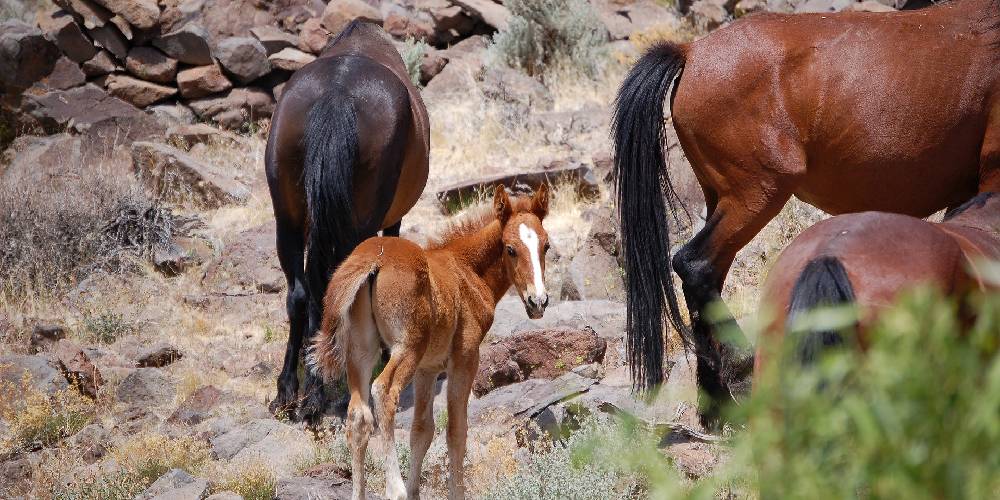
In the wild, the average lifespan of a Mustang is between 15 and 20 years, but if they are kept in captivity and cared for by people, they have an average lifespan of 30 years which is average for a horse.
Are There Too Many Mustangs In The Wild?
Yes, there are too many mustang horses in the wild for the landscape and vegetation to support them. Because of this, the BLM (Bureau Of Land Management) has several roundups of these mustangs to get the horses out of the area. These horses then can be bought at auction or are relocated to different areas.
One of the places that the mustangs might go is to the Mustang Makeover Challenge. Like I said before, in this program, the mustangs are trained and shown in the span of 100 days before being auctioned off.
Another place that these horses might end up is a less horse populated area that mustangs live on with more vegetation to support them. This way, the horses are still wild, but in an area that is better for both them and the land.
Another place that these horses may go is straight to auction. These horses can be auctioned off or purchased by people who want to turn them out on their own properties, train them to be ridden, or have them as pets. This way, they get off the land that is struggling to support them, and they go into loving homes.
Some prisons have equine programs where inmates are allowed to work with an train horses. This program is great for both horses and people as the people are given more meaning to their life and they can do something useful in their sentenced time. The horses are given new homes where it isn’t so hard to survive, they have health care available, and its easier to find food.
Fun Facts On Mustangs
- In the wild, mustangs can travel up to 20 miles per day
- In a herd of wild mustangs, there are two lead horses, a stallion and a lead mare. The stallion stays at the back of the herd to protect it and keep a lookout. The lead mare leads the herd in whatever direction they are supposed to be going in. All herd members are protected by the lead stallion and led by the lead mare.
- They can come in any shape, size, color, or pattern
FAQs On Mustang Horses
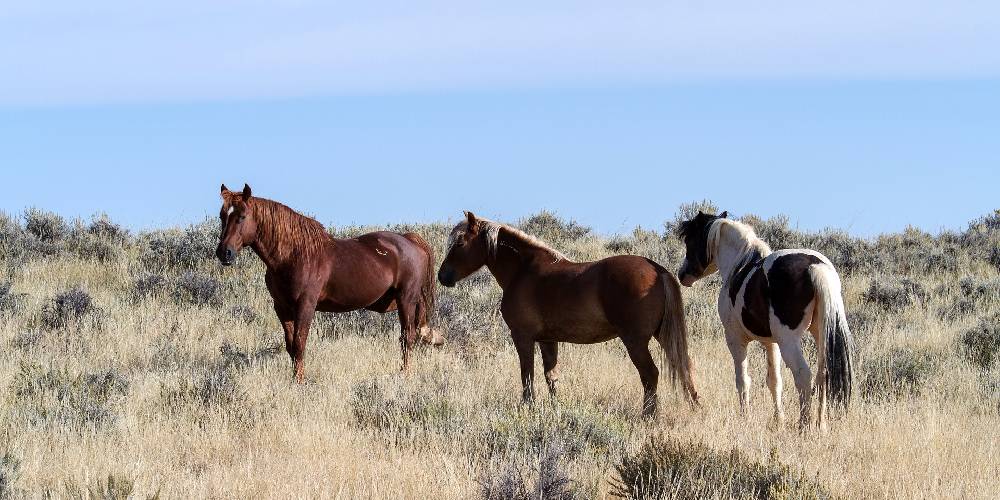
Are Mustang horses hard to train?
Every horse is different. Some horses are trusting and are willing to work with people and submit to them while others are strong minded and are less likely to let people mount and guide them.
Compared to other breeds of horses they can be harder to train because they haven’t ever been around people where as domesticated horses are raised around people.
Are these horses expensive?
Generally no, it isn’t hard to get a mustang for a cheap price. Sometimes, you can even buy a wild mustang for just a couple hundred dollars from the BLM. Sometimes, however, if a mustang is really well trained, young, and has visible traits carried from the Spanish horses brought to North America, they can sell for well over $10,000.

